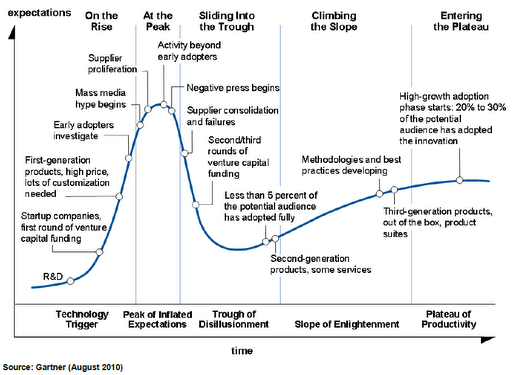Mar 8, 2012 (From the CalCars-News archive)
Many plug-in advocates have been feeling frustrated about the Chevy Volt. It's an inspiring example of innovation, a milestone of advanced technology, and a pioneering vision of how to start getting off fossil fuels. Now its factory is closing for five weeks to clear inventory. What's the Volt's future? Can it resume its successful trajectory?
POLITICAL FOOTBALL: As GM CEO Daniel Akerson told Senators in January, the Volt has gone from "technological wonder" to "political punching bag." For some examples of how a car welcomed by the Bush Administration first turned into "Obama's car," then became a product that critics hoped would fail, see Joe Romm's roundup at http://thinkprogress.org/romm/2012/03/03/437116/limbaugh-fox-news-tea-party-false-attacks-chevy-volt-gm-lay-offs/ .
WHERE ARE WE ON THE ADOPTION CURVE? For over a decade, the Gartner consulting firm has been situating products and technologies along a graph it calls the Emerging Technology Hype Cycle. See an example at http://bimeanalytics.com/wp-content/uploads/2010/08/gartner-hype-cycle.png . It features a rapid rise of expectations, fueled by early adopter enthusiasm, with an early Peak of Inflated Expectations followed by a rapid slide that ends in a Trough of Disillusionment. From there, SUCCESSFUL products go through second- and third-generation refinements and gradually rise through a Slope of Enlightenment to a Plateau of Productivity. How will the Volt get through the Trough?

WHAT'S THE LIKELY IMPACT OF THE FIVE-WEEK THE PRODUCTION HALT? We fear that without energetic responses, opponents will tarnish the Volt as a failure. Advocates have our work cut out for us -- and we can't just look backward or gripe! For some insights, green car journalist/consultant Michael Coates evaluates the GM work stoppage based on his deep experience in automotive marketing. Centrally, he points out that a slowdown is better than a glut. See http://www.plugincars.com/why-chevy-volt-showdown-good-thing-plug-ins-113605.html . The 65 comments to date, many of which include replies by Coates, are very much worth reading!
NO RETREAT: It would be a mistake to conclude from the pause that it's time to ratchet DOWN our expectations for the Volt. We still need to find ways to get hundreds of thousands of them on the road. All the energy security, climate, economic and social benefits impelling GM and the world's auto industry to evolve still hold. The Volt and other plug-in vehicles remain at the core of a global imperative to get off fossil fuels ASAP.
PRICING: In these challenging economic times, more buyers need to know they can lease a Volt for about $350/month. And purchasers need to hear Volt owners crow that they got a BMW-level car at half the price. Though the Chevy Cruze is often in the same showroom (and dealers may make more money selling them), GM needs to re-position the Volt so it's NEVER compared to this budget car with which it shares a "platform." Volkswagen has managed to avoid people wondering why they should buy an Audi when it costs so much more than a Passat. And will anyone ponder whether to save money by buying the new Dodge Dart instead of the same-platform Alfa Romeo Giulietta?
SAFETY: Quick headlines about battery fires partly eclipsed appreciation of the Volt's universally stellar safety ratings. We find humorous responses most effective: "If you crash your car, don't stay inside for a few weeks. And make sure you don't leave it turned upside down until it's repaired." GM did a good job with its customer satisfaction policies and safety modifications. And in December, it took only a hundred or so Volt owners declaring "We're keeping our keys" on Facebook to counter much of the unprincipled misinformation.
SALES REPUTATION: Pointing out that first-year Volt and Leaf sales far exceeded initial Prius levels didn't offset negative headlines. Now that GM has halted production for five weeks in a catch-up move, advocates and owners need to step up their visible efforts. We can only imagine how things would be different if automakers maximally leveraged their satisfied customers as their best allies. Sites like http://www.facebook.com/groups/chevyvoltowners/ and the new http://www.voltstats.net help -- but the message has to go beyond that.
HAPPY VOLT: GM has just launched a new series of videos showing owners http://www.chevroletvoltage.com/index.php/videos.html . But just as many were put off by the Volt Superbowl ad showing strange aliens and awkward people, the first three of a promised dozen ads feature people with unusual names making odd points, sometimes in foreign accents or drowned out by music. GM could spotlight reassuring people saying, "I love my Volt. It drives just like any other car -- just zippier, quieter, and using almost no gas." CNN found one easily: http://money.cnn.com/video/news/2012/02/28/n_chevrolet_volt_owner.cnnmoney/
RECRUITING BUYERS: As the automakers pitch their cars through ads and social media, advocates can build on their efforts, with a harder sell than GM's ads. At least four constituencies can be buyers: fans of early technology, people who don't want to fund petro-dictatorships, environmentalists, and the LOHAS market segment (tens of millions of households willing to pay more up front for Lifestyles of Health and Sustainability).
GO FOR THE GREEN: The quickest response can come from the environmentally-focused car-buyers. Green groups' websites and newsletters already promote the benefits of plug-in cars. Their members may have missed much of the negative spin. And they'll be receptive to the message that switching to a plug-in car could have a greater impact on their "footprint" than other purchases.
WE URGE CALCARS-NEWS READERS to ask their organizations to transform current informational efforts into CAMPAIGNS. Just as they have done for compact fluorescent bulbs, hybrid cars, and rooftop solar, they can urge their millions of members to buy PHEVs and EVs and distribute branded plug-in bumper stickers. They can tie in to other networks to offer every member a test-drive with a happy owner. Imagine how quickly even one group with hundreds of thousands of members could generate tens of thousands of sales. That turn of the tide could leave automakers with a challenge worth having: building enough plug-in vehicles to meet a steadily-growing demand.



